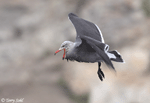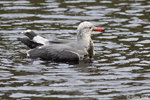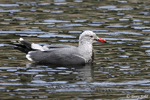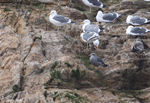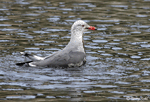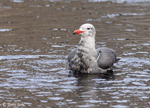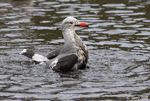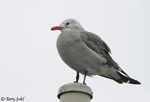| Length: 18-20 inches | Wingspan: 50 inches | Seasonality: Non-resident in South Dakota |
| ID Keys: Sooty gray overall, with dark gray above, gray underneath, bright red bill with red tip | ||
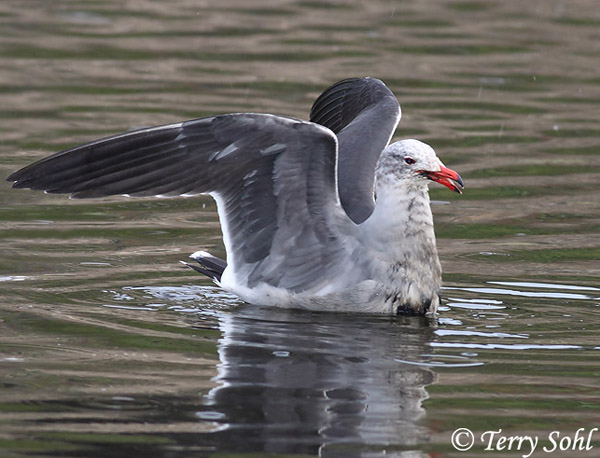 The
Heermann's Gull is a beautiful and unique gull of the Pacific Coast.
They have an extremely limited breeding range, with 90% of the world's
population of the species breeding on a single island in Mexico, Isla Rasa.
However, they disperse widely after the breeding season, with birds
regularly moving north along the Pacific Coast as far as British Columbia.
Their movements northward appear to be timed to the movements of
Brown Pelicans. Heermann's Gulls
will often follow Brown Pelicans, attempting to steal fish that Pelicans (or
other birds) have caught.
The
Heermann's Gull is a beautiful and unique gull of the Pacific Coast.
They have an extremely limited breeding range, with 90% of the world's
population of the species breeding on a single island in Mexico, Isla Rasa.
However, they disperse widely after the breeding season, with birds
regularly moving north along the Pacific Coast as far as British Columbia.
Their movements northward appear to be timed to the movements of
Brown Pelicans. Heermann's Gulls
will often follow Brown Pelicans, attempting to steal fish that Pelicans (or
other birds) have caught.
Habitat: Mostly found near the Pacific Coast, close to the shoreline. There, it will use a variety of habitats outside of the breeding season, depending on food availability. They are extremely rare away from the coast, typically not even venturing a few miles from the ocean. They can sometimes be found far out to sea, however.
Diet: Feeds heavily on small fish, as well as other marine life such as small crustaceans, mollusks, insects, and marine worms. Will also occasionally steal eggs from nests, and will feed on human refuse.
Behavior: When searching for fish, they fly close to the ground, dipping down to the water's surface or plunging into the water when a fish is spotted. Stealing fish and other food from other birds is another favored foraging technique. They will occasionally feed on human refuse, but not as much as many other gull species.
Nesting: The nest of a Heermann's Gull is often just a simple scrape on the ground with a minimal lining of grasses and feathers. Both the parents help to incubate the eggs. Both parents feed the young upon hatching.
Song: Has a nasal koww call, but is usually silent when away from their breeding grounds. On the breeding grounds, has a low-pitched, nasal trumpeting call.
Migration: Heermann's Gulls consistently move northward along the Pacific coast after the breeding season. While nearly all breeding occurs on Isla Rasa island in Mexico, post-breeding dispersal brings birds as far north as British Columbia in the summer months.
Interactive eBird Map: Click here to access an interactive eBird map of Heermann's Gull sightings
Similar Species: Distinctive gray plumage and red bill make the Heermann's Gull distinctive and unlikely to be confused with other gull species, if seen well.
Conservation Status: Nearly 90% of the world's population of Heermann's Gulls nest on one island. Populations also seem to rise and fall in association with cliamte events, particularly El Nino Southern Oscillation shifts in the Pacific. Given the extremely small breeding range and the threat of the effects of climate change, the IUCN lists the Heermann's Gull as "Near Threatened".
Further Information: 1) BirdWeb.org - Heermann's Gull
2) Audubon's Field Guide - Heermann's Gull
3) ARKive.org - Heermann's Gull
Photo Information: Photo taken on December 18th, 2008 - Pacific coast near San Francisco, California - Terry Sohl
| Click below for a higher-resolution map |
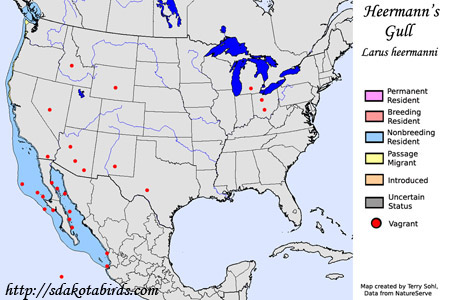 |
| South Dakota Status: Non-resident in South Dakota |
Additional Heermann's Gull Photos
Click for a higher-resolution version of these photos
